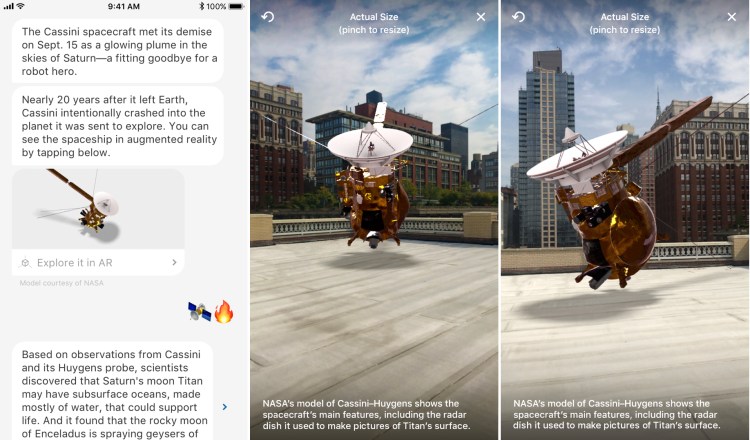Quartz is known for its news app that delivers the day’s events in short conversational pieces, allowing readers to dive into more detail if they want or move on to the next story. It’s structured like a text conversation with a friend, parceling out each piece of information in message bubbles and aping the format of the chat bots that were all the rage this time last year. Now it’s incorporating another tech trend into its app — augmented reality.
Apple’s been hyping its iOS 11 AR capabilities since it unveiled its software developer kit ARKit at the Worldwide Developers Conference earlier this year. And now that iOS 11 has rolled out to all users with compatible devices, users are starting to see AR pop up in various places, such as Major League Baseball’s At Bat and Fifth Star Lab’s Sky Guide. Quartz has also taken the opportunity to incorporate some lightweight AR into its app, first with a 3D rendering of the Cassini probe that recently entered an early, permanent retirement on Saturn.
“We currently illustrate our news stories with not only images and videos, but also emoji and animated GIFs,” said John Keefe, Quartz’s product manager, in a phone call with VentureBeat. “We decided that it would also be cool to incorporate 3D news objects into it. Since Apple made it pretty easy for us, we got to it right away. We have a developer on staff who started playing with it.”
Keefe says the Quartz team has been working on the AR feature for a few weeks now, and the main issue they’ve encountered is actually finding the 3D models to begin with. They’ve found marketplaces where people create 3D models for others to buy or download, and they’ve experimented with using their own scanning device. Their Cassini model came from NASA, which Keefe says has a number of models available.
Finding the models is only the first step. Keefe says that they want the models to be as realistic as possible, so lighting is often a consideration. He says that ARKit does take care of some of the work, but they still have to make adjustments, such as how reflective certain surfaces are.
“You’ll look at something and be like, hey, that’s not supposed to be shiny, or it is supposed to be shiny,” said Keefe. “That’s usually what we’re trying to adjust. As more and more people are making these 3D models, however they make them, it’s going to get easier to incorporate them.”
Keefe says that they’re aiming to always have at least one AR story in the app, but of course, that depends on what’s happening in the news at any given time. The benefit for readers, he says, is that it gives them a new way of experiencing the news.
“One of the neat things about the Cassini model to me is I never really had a sense of how big Cassini was,” said Keefe. “You see pictures of it and animations that are usually with Saturn in the background, but you have no clue. Is this the size of a building, a car, a lunch box? It turns out that with AR you can put it in your living room and be like, OK, now I get a sense of the size of it.”
Right now, the interaction with the 3D models is limited to simply walking around them or resizing them, but Keefe says that the team is working on adding other features. They don’t expect users to spend a lot of time with the AR feature, since their whole model is to deliver bite-sized bits of information that can be quickly digested. That being said, Keefe said that they’ve received requests from users for an AR gallery so that they can revisit past models, and that’s something they’re looking into.
In the past, other news publications have tackled new tech, such as The New York Times‘ use of virtual reality and 360-degree experiences. Keefe says that they’re at an advantage with AR because it’s a lot less labor than creating VR experiences, which he likens to creating a documentary.
“With AR, we have the benefit of taking advantage of the world that’s actually around you,” said Keefe. “We don’t have to re-create your world, which saves us a lot of work. And then we can add to that. That’s the augmented reality part. The additive concept is just an easier lift to begin with. It allows us to get a bit more experimental and playful.”

